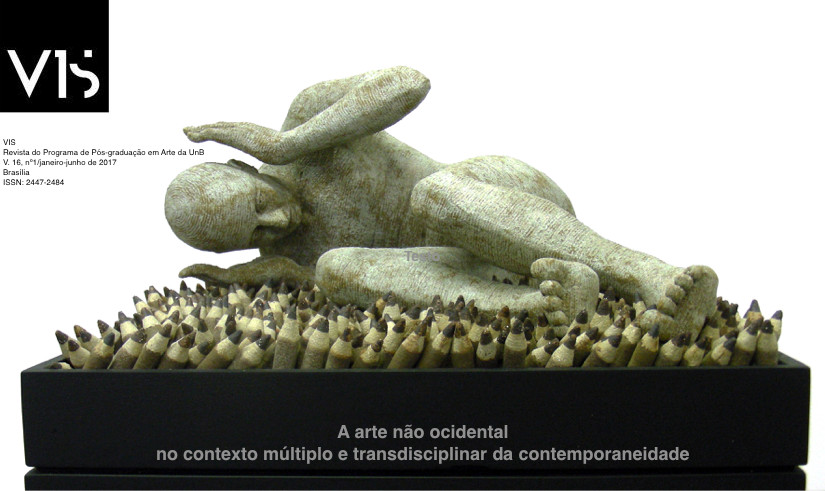Os 500 Arhats
o retorno de Murakami Takashi e a transformação da arte japonesa
DOI:
https://doi.org/10.26512/vis.v16i1.20486Keywords:
Art. Tradition. Modernity. Post-Fukushima. Murakami Takashi.Abstract
Murakami Takashi is one of the most celebrated contemporary international artists. His exhibitions, held at the greatest museums in the world and in famous places such as the Rockefeller Center or the Palace of Versailles, have attracted millions of visitors, fueled the artist’s popularity and created a legion of admirers inside and outside Japan. Murakami, whose achievement counts on the joint work of hundreds of people, impresses by the dimensions, the quality and the use of digital media. Through his art, Murakami manages to blend traditional iconography with that of manga, and the trends of otaku culture with foreign influences in postwar Japanese society. In October of 2015, after 14 years of absence of the artistic scene of his country, Murakami decided to expose again in Tokyo, in the Museum Mori. The result was The 500 Arhats exhibition, a series of new works that have as their theme art, religion, death and human limitations. The title of the exhibition refers in particular to a painting 120 meters long (one of the largest ever made in the history of world art), which was originally produced for the State of Qatar as a personal way of thanking of the artist for the support Japan received from that country after the 2011 Tsunami. The proposal of this article is to analyze the meaning and importance of the Murakami exhibition in today’s cultural context of Japan, and at the same time, it aims to reflect about his role as an artist and his complex relationship with some aspects of Japanese cultural tradition.
Downloads
References
AZUMA, Hiroki. Generazione otaku: uno studio sulla postmodernità . Milano: Jaca Book, 2010.
_______________. Superflat Japanese Post-Modernity. 2001. Disponível em: <http://ha.shiftweb.net/en/texts/superflat_en1.html>. Acesso em: 05 nov.2012.
BENZON, William L. Godzilla’s children: Murakami takes Manhattan. Mechademia 2.1, p. 283-287, 2007.
BERQUE, Augustus. Identification of the self in relation to the environment. In: Nancy ROSENBERGER, Nancy (Org.). Japanese sense of self. Cambridge, New York, Melbourne: Cambridge University Press, 1994. p. 93-104.
BORNOFF, Nicholas. Sex and consumerism: the Japanese state of the arts. In: LLOYD, Fran (Org.). Consuming bodies: sex and contemporary Japanese art. London: Reaktion Books, 2002. p. 41-68.
BREHM, Margrit. The art in the floating world that almost was. In: BREHM, Margrit (Org.). The Japanese experience inevitable. Ostfildern: Hatje Cantz Publishers, 2003. p. 8-19.
CRUZ, Amanda. DOB in the land of otaku. In: CRUZ, Amanda; MATSUI, Midori ; FRIIS-HANSEN, Dana; MURAKAMI, Takashi (Orgs.). Takashi Murakami: the meaning of the nonsense of the meaning. New York: Harry N. Abrams, 1999. p. 14-19.
DARLING, Michael. Past + Present = Future. In: KIKI, Kaikai & MUSEUM OF CONTEMPORARY ART TOKYO (Orgs.). Takashi Murakami: summon monsters? open the door? heal? or die? Tokyo: Kaikai kiki Co. Ltd., 2001. p.64-71.
_______________. Plumbing the depths of Superflatness. Art Journal, v. 60, n. 3, p. 79-89, 2001.
FABBRI, Fabriano. Lo zen e il manga. Arte contemporânea giapponese. Milano: Bruno Mondadori, 2009.
FAVELL, Adrian. Before and after Superflat: a short history of Japanese contemporary art ”“ 1990-2011. Hong Kong: Blue Kingfisher limited, 2001.
FRIIS-HANSEN, Dana. The meaning of Murakami’s nonsense: about “Japan” itself. In: CRUZ, Amanda; MATSUI, Midori; FRIIS-HANSEN, Dana; MURAKAMI, Takashi (Orgs.). Takashi Murakami: the meaning of the nonsense of the meaning. New York: Harry N. Abrams, 1999. p. 30-41.
FURUKAWA, Hideo. Umatachi yo, soredemo hikari wa muku de. Tóquio: ShinchÅsha, 2011.
GEBHARDT, Lisette; MASAMI, Yuki. Literature and art after “Fukushima”. Berlin: Hubert & Co., 2014.
GIONI, Massimiliano. Takashi Murakami ”“ Ego Mix: some facts and fictions about the life and work of Takashi Murakami. In: TAKASHI, Murakami (Org.). Murakami: Ego. New York: Skira Rizzoli, 2012. p. 115-118.
GLUCK, Carol. The invention of Edo. In: VLASTOS, Stephen (Org.). Mirror of Modernity: invented traditions of Modern Japan. Berkeley: California University Press, 1998. p. 262-284.
GOMORASCA, Alessandro (Org.). La bambola e il robottone: culture pop nel Giappone contemporâneo. Torino: Einaudi, 2001.
HAROOTUNIAN, Harry. Visible discourses / invisible ideologies. In: MIYOSHI, Masao; HAROOTUNIAN, Harry (Orgs.). Postmodernism and Japan. Durham: Duke University Press, 1997. p. 63-92.
IWABUCHI, KoÌ„ichi. “Soft” nationalism and narcisism: Japanese popular culture goes global. Asian Studies Review, v. 26, n. 4, p. 447-469, dez. 2002.
KARATANI, Kōjin. One spirit, two nineteenth centuries. In: MASAO, Miyoshi; HAROOTUNIAN, Harry (Orgs.). Postmodernism and Japan. Durham: Duke University Press, 1989. p. 259-272.
KATO, ShÅ«ichi. Arte e Societá in Giappone. Torino: Edizioni dela Fondazione Agnelli, 1990.
KELTS, Roland. The Japanese soul. Nihilism and Revolution, Jul.-Aug., 2009.
KINSELLA, Sharon. Adult Manga: culture and power in contemporary Japanese society. Richmond Surrey: Curzon Press, 2000.
KOYAMA, Tomio. How to understand contemporary art. Art award Tokyo Marunouchi. 2010. Disponível em: <http://www.marunouchi.com/e/culture/art-award_10_07.html>. Acesso em: 25 mar. 2016.
LAMARRE, Thomas Mark. An introduction to Otaku Movement. Enter Text, v. 4, n. 1, 2004, p. 151-87.
LUBOW, Arthur. The Murakami method. 2005. The New York Times Magazine. Disponível em: <http://www.nytimes.com/2005/04/03/magazine/03MURAKAMI.html>. Acesso em: 13 fev. 2016.
MATSUI, Midori. Beyond the pleasure room to a chaotic street: transformations of cute subculture in the art of the Japanese nineties. In: MURAKAMI, Takashi (Org.). Little Boy: the arts of Japan’s exploding subculture. London: Yale University Press, 2005. p. 209-236.
_______________. Takashi Murakami: interview. Index Magazine. 1998. Disponível em: <http://www.indexmagazine.com/interviews/takashi_murakami.shtml>. Acesso em: 18 dez. 2016.
_______________. The Age of Micropop: the new generation of Japanese artists. Tokyo: Parco Co. Ltd., 2007.
_______________. Toward a definition of Tokyo Pop. In: CRUZ, Amanda; MATSUI, Midori; FRIIS-HANSEN, Dana; MURAKAMI, Takashi (Orgs.). Takashi Murakami: the meaning of the nonsense of the meaning. New York: Harry N. Abrams, 1999. p. 20-29.
MCGRAY, Douglas. Japan’s gross national cool. Foreign Policy, n. 130, maio-jun. 2002, p. 44-54. Disponível em: <http://www.foreignpolicy.com/articles/2002/05/01/japans_gross_national_cool?page=full>. Acesso em: 18 dez. 2016.
MIKI, Akiko. Takashi Murakami’s The 500 Arhats: return and rebirth. In: MURAKAMI, Takashi. Murakami Takashi ”“ The 500 Arhats. Tokyo: Mori Museum, 2016.
MIYAKE, Toshio, Occidentalismi. La narrativa storica giapponese, Venezia, Cafoscarina, 2010.
_______________. Mostri made in Japan: orientalismo e auto-orientalismo nell’era della globalizzazione. In: CASARI, Matteo (Org.). Culture del Giappone contemporaneo. Latina: Tunué, 2011. p. 165-197.
_______________. Occidentalismi: la narrativa storica giapponese. Venezia: Cafoscarina, 2010.
MÓ„RI, Yoshitaka. Subcultural unconsciousness in Japan: the war and Japanese Contemporary Artists. In: ALLEN, Matthew; SAKAMOTO, Rumi (Orgs.). Popular culture, globalization and Japan. New York: Routledge, 2006. p. 175-191.
MUNROE, Alexandra (Org.). Japanese after 1945: scream against the sky. New York: Harry N. Abrams, 1994.
_______________. Introducing Little Boy. In: MURAKAMI, Takashi (Org.). Little Boy: the arts of Japan’s exploding subculture. London: Yale University Press, 2005. p. 241-258.
_______________. Scream against the sky. In: MUNROE, Alexandra (Org.). Japanese after 1945: scream against the sky. New York: Harry N. Abrams, 1994. p. 19-24.
MURAKAMI, Takashi. A theory of Super Flat Japanese art. In: MURAKAMI, Takashi. Superflat. Tokyo: Madra, 2000. p. 15.
_______________. Earth in my window. In: MURAKAMI, Takashi (Org.). Little Boy: the arts of Japan’s exploding subculture. London: Yale University Press, 2005. p. 99-149.
_______________. Ego. New York: Skira Rizzoli, 2012.
_______________. Impotence culture ”“ Anime. In: MURAKAMI, Takashi. My reality ”“ contemporary art and the culture of Japanese animation. New York: Independent Curators International, 2001. p. 56-66.
_______________. Kaikai Kiki Company Ltd. Disponível em: . Acesso em: 18 dez. 2016.
_______________. Life as a Creator. In: KAIKAI KIKI & MUSEUM OF CONTEMPORARY ART TOKYO (Orgs.). Takashi Murakami: summon monsters? Open the door? Heal? Or die? Tokyo: Kaikai Kiki Co. Ltd., 2001. p. 130-147.
_______________. Murakami Takashi ”“ The 500 Arhats. Tokyo: Mori Museum, 2016.
_______________. Superflat trilogy: greetings, you are alive. In: MURAKAMI, Takashi (Org.). Little Boy: the arts of Japan’s exploding subculture. London: Yale University Press, 2005. p. 151-161.
_______________. Superflat. Tokyo: Madra, 2000.
_______________. The Super Flat Manifesto. Super Flat. Tokyo: Madra, 2000.
MURAYARI, Gary-Carrion. Takashi Murakami ”“ The 500 Arhats. In: MURAKAMI, Takashi (Org.). Ego. New York: Skira Rizzoli, 2012. p. 119-122.
NAPIER, Susan. Anime from Akira to Princess Mononoke: experiencing contemporary Japanese animation. New York: Palgrave, 2001.
NATILI, Donatella. WagÅ RyÅ«ichi. Revista Brasileira, Academia Brasileira de Letras, Fase VIII, ano v, n. 87, p. 247-261, abril-maio-junho 2016. Disponível em:<http://www.academia.org.br/sites/default/files/publicacoes/arquivos/revista_brasileira_87. pdf>. Acesso em: 28 fev. 2017.
OKADA, Toshio; MORIKAWA, KaichiroÌ„; MURAKAMI, Takashi. Otaku Talk. In: MURAKAMI, Takashi (Org.). Little Boy: the arts of Japan’s exploding subculture. London: Yale University Press, 2005. p. 164-185.
PEREZ, Magdalene. Artinfo. 7 mar. 2007. Disponível em: <http://www.artinfo.com/news/story/17056/takashi- murakami>. Acesso em: 18 dez. 2016.
ROSENFIELD, John M.; CRANSTON, Fumiko E.; RICHARD, Naomi Noble. Extraordinary persons, Kinsei kijin no geijutsu: works by eccentric,nonconformist Japanese artists of the early modern era (1580-1868) in the collection of Kimiko and John Powers. Cambridge: Harvard University Art Museums, 1999.
ROSENFIELD, John M.; CRANSTON, Fumiko E.; RICHARD, Naomi Noble; SALTZ, Jerry. Imitation Warhol. The Village Voice, 24 ago. 1999. Disponível em: <http://www.villagevoice.com/1999-08-24/art/imitationwarhol/>. Acesso em: 20 mar. 2016.
SAWARAGI, Noi. Nihon - Gendai - Bijutsu. Tokyo: Shinchosha, 1998.
_______________. On the battlefield of “Superflat”: subculture and art in postwar Japan. In: MURAKAMI, Takashi (Org.). Little Boy: the arts of Japan’s exploding subculture. London: Yale University Press, 2005. p. 187-205.
SIEGEL, Katy. In the air. In: MURAKAMI, Takashi (Org.). Little Boy: the arts of Japan’s exploding subculture. London: Yale University Press, 2005. p. 269-287.
STEINBERG, Marc. Emerging from Flatness: Murakami Takashi and Superflat aesthetics. 2002. 231 f. Dissertation (Master in Arts) ”“ Faculty of Graduate Studies and Research, East Asian Studies Department, McGill University, Montreal, 2002.
_______________. Otaku consumption, Superflat art and the return to Edo. Japan Forum, v. 16, n. 3, p. 449-471, 2004.
TSUJI, Nobuo. Lineage of Eccentrics. Tokyo: Kaikai Kiki, 2012.
_______________. The playfulness in Japanese art. Lawrence, Kansas: Spencer Museum of Art; The University of Kansas, 1986.
UENO, Toshiya. Japanimation and Techno-Orientalism. Disponível em: <http://www.t0.or.at/ueno/japan.htm>. Acesso em: 13 mar. 2016.
VOGEL, Carol. The Warhol of Japan pours ritual tea in a Zen moment. The New York Times Magazine, 7 maio 2007. Disponível em: <http://www.nytimes.com/2007/05/07/arts/design/07mura.html?n=Top%2fReference%2fTimes%20Topics%2fPeople%2fM%2fMurakami%2c%20Takashi&_r=0>. Acesso em: 5 maio 2016.
WAKASA, Mako. Takashi Murakami (interview). Journal of Contemporary Art, 24 fev. 2000. Disponível em: <http://www.jcaonline.com/murakami.html>. Acesso em: 18 dez. 2016.
WEISENFELD, Gennifer. Rescribing Tradition in a Transnational Art World, Transcultural Studies, 2010.
YODA, Tomiko. A roadmap to Millennial Japan. The South Atlantic Quarterly, v. 99, n. 4, p. 629-668, 2000.




